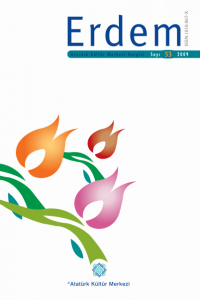Abstract
Koleksiyoncularda, halı mağazalarında ve alan araştırmalarında karşılaşılan en büyük problemlerden başlıcaları; bulunan örneğin doğru bir
şekilde teknik analizinin yapılması, desen ve motiflerinin tanımlanması ve bu bilgilerin ışığında halının bir gruba aidiyetinin saptanmasıdır.
Bir koleksiyonerin evinde tespit edilen bir örneğin gerekli analizleri
yapıldıktan sonra; “bahçe” desenli İran halısı olduğu anlaşılmıştır. Yazılı kaynaklara göre en eski örneklerinin 16. yüzyıla ait olduğu bilinen
fakat bu yüzyıla ait örneklerin günümüze ulaşmadığı özel bir gruptur.
Günümüze ulaşabilen örnekler 18. ve 19. yüzyıllara aittir. İran’da bu
tür bahçeler chahar bagh (dört bahçe) ismiyle tanımlanmaktadır. Klasik
İran halılarının arasında yüzey kompozisyon planı açısından çok farklı
özellikler göstermektedir. “Bahçe” desenli halılar; tarihi bahçe tasarımlarının İslam dini ile olan sentezinin sonucunu sunduğu için tüm araştırmacılar için önemli bir örneği oluşturmaktadır.
Keywords
References
- Alia, F. H (1999), “Overwiev of Islamic Garden”, www.suite101.com, (18.10.2007)
- Bennett, I. (1972), Book of Oriental Carpets, London, Hamlyn Publishing, s. 49-80.
- Erdmann, K. (1970), Seven Hundred Years of Oriental Carpets, London:Faber and Faber Limited, s. 66-70.
- Erdmann, K. (1985), Der Orientalische Knüpfteppich: Versus Einer Darstellung Seiner Geschichte, München: Wasmuth Ernst Verlag (Gebundese Ausgabe), s. 32-47.
- Genç, G. (2002), “Geçmişten Günümüze Bahçelerde Yaşam Kültürü”, Antik ve Dekor, S.70, Nisan Mayıs, Antik A.Ş., s. 136-149.
- Kaleli Çavdar, Z, (2007), “İran Halılarında Kullanılan Desen ve Kompozisyon Özellikleri”, 1. Uluslararası Türk El Dokumaları Kongresi, S.Ü. Selçuklu Araştırmaları Merkezi Başkanlığı Yayınları, s. 143-150.
- Schlosser, I. (1979), Der Schöne Teppich in Orient Und Okzident, München: Taschenbuch Verlag GmhH & Co. Kg., s. 37-54, Historische Teppiche plate. 29-72.
- www.persia.org/Images/Persian_Carpet/ old_jpg1.html,, (14.12.2008)
- www.reep.org/islamic-gardens/design-chaharbagh layout, (15.10.2007)
- www.britishmuseum.org/ garden_pool_fragment, (21.10.2007)
- www.superbherbs.net/design, “History of Garden Design / The Persian Carpet Influence”, (15.10.2007)
- www.oznet.net/cyrus/paradise, (15.10.2007)
- www.taj-mahal.net, (21.10.2007)
Abstract
There are three main problems in carpet collections, carpet markets or
area searches, namely, making a true technical analysis, defining the
motifs and designs and identifying the group that the carpet belongs
to. After a carpet was found in a collector’s house and the technical
analysis was made, we understood that it was an Iranian “garden” design carpet. According to the written documents, the oldest Iranian
“garden” design carpets were dated back the 16th century. But there
is not sample of such 16th century carpets today. Since only the 18th
and 19th century samples can be found, such a carpet is highly special.
These gardens in Iran are called as the chahar bagh (four gardens). The surface composition plans of these carpets are different from the classical
Iran carpets. The “Garden” design carpets show both ancient garden
designs and Islamic garden ideas (Heaven Garden); and in these sense
they are very important for the researchers.
References
- Alia, F. H (1999), “Overwiev of Islamic Garden”, www.suite101.com, (18.10.2007)
- Bennett, I. (1972), Book of Oriental Carpets, London, Hamlyn Publishing, s. 49-80.
- Erdmann, K. (1970), Seven Hundred Years of Oriental Carpets, London:Faber and Faber Limited, s. 66-70.
- Erdmann, K. (1985), Der Orientalische Knüpfteppich: Versus Einer Darstellung Seiner Geschichte, München: Wasmuth Ernst Verlag (Gebundese Ausgabe), s. 32-47.
- Genç, G. (2002), “Geçmişten Günümüze Bahçelerde Yaşam Kültürü”, Antik ve Dekor, S.70, Nisan Mayıs, Antik A.Ş., s. 136-149.
- Kaleli Çavdar, Z, (2007), “İran Halılarında Kullanılan Desen ve Kompozisyon Özellikleri”, 1. Uluslararası Türk El Dokumaları Kongresi, S.Ü. Selçuklu Araştırmaları Merkezi Başkanlığı Yayınları, s. 143-150.
- Schlosser, I. (1979), Der Schöne Teppich in Orient Und Okzident, München: Taschenbuch Verlag GmhH & Co. Kg., s. 37-54, Historische Teppiche plate. 29-72.
- www.persia.org/Images/Persian_Carpet/ old_jpg1.html,, (14.12.2008)
- www.reep.org/islamic-gardens/design-chaharbagh layout, (15.10.2007)
- www.britishmuseum.org/ garden_pool_fragment, (21.10.2007)
- www.superbherbs.net/design, “History of Garden Design / The Persian Carpet Influence”, (15.10.2007)
- www.oznet.net/cyrus/paradise, (15.10.2007)
- www.taj-mahal.net, (21.10.2007)
Details
| Primary Language | Turkish |
|---|---|
| Journal Section | Erdem |
| Authors | |
| Publication Date | April 1, 2009 |
| Published in Issue | Year 2009 Issue: 53 |
ERDEM Journal is indexed by TR Dizin, MLA International Bibliography, EBSCOhost, SOBIAD, ASI (Advanced Science Index) ISAM, DAVET and AYK Journal Index.


